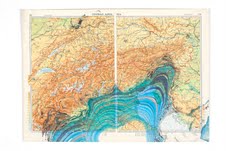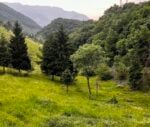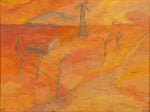Pascal Schwaighofer / Misha Stroj

Il progetto espositivo presenta le prime personali italiane di Misha Stroj (1974, vive e lavora a Vienna) e Pascal Schwaighofer (1976, vive e lavora a Mendrisio e Rotterdam).
Comunicato stampa
Il progetto espositivo presenta le prime personali italiane di Misha Stroj (1974, vive e lavora a Vienna) e Pascal Schwaighofer (1976, vive e lavora a Mendrisio e Rotterdam).
Entrambi gli artisti condividono un approccio di carattere analitico al loro lavoro e sono orientati a interrogare i mezzi e la natura del linguaggio artistico ancora prima di interessarsi a temi e argomenti determinati. La mostra è in tal senso uno scacchiere di posizioni, di contrasti e assonanze intuitive tra i diversi lavori.
Il lavoro di Misha Stroj prende avvio da ricerche storiche e sociali sui luoghi in cui egli espone. In diverse opere l’artista affronta il tema dei rapporti economici e delle forze materiali operanti nella società e nell’industria culturale, sino a mettere in questione i meccanismi stessi del sistema dell’arte e la logica di cosa determini il valore e il significato di un’opera d’arte. Le opere in mostra informano un racconto personale istruito nei termini di una paradossale narrazione intima in cui il vissuto personale dell’artista compare trasfigurato e letto in relazione con elementi tratti dalla storia economica europea e dalla cultura italiana letteraria del secondo Novecento.
Die Säule mit dem Knie (2010) unisce in un'unica scultura un calco del ginocchio di Stroj e una colonna d’acciaio della stessa altezza dell’artista prelevata da uno stabilimento industriale abbandonato a Berlino. Quasi un ironico autoritratto dell’artista al tempo della crisi del mondo industriale in Europa, la scultura è un’unione antitetica di due materiali lontanissimi tra loro, dove il calco in gesso, forma evocativa del corpo umano, prova ad animare la colonna di acciaio, residuo pesante della memoria industriale novecentesca. Prosegue su un versante di spiazzante autobiografia anche Index Broken (2012), calco della mano dell’artista il cui dito indice appare spezzato. Come un riferimento indicativo al rapporto tra identità personale e mondo esterno, tra cognizione di sé e alterità, Index Broken appare un tentativo di comunicazione visiva interrotto a metà strada da ragioni ignote e irrevocabili. Intorno ad altri interventi dell’artista in mostra aleggia il riferimento ideale alle pagine de La vita agra di Luciano Bianciardi. Pubblicato nel 1962 e capace di interpretare anzitempo il boom economico italiano degli anni Sessanta e il suo impatto sui costumi sociali degli Italiani, catturati dalla società dei consumi e da ritmi di lavoro di tipo industriale, l’opera di Bianciardi è nelle riflessioni di Stroj uno strumento di analisi privilegiato. Che rapporto c’è oggi in Europa tra libertà creativa e industria culturale e che possibilità di azione è rimasta agli artisti? Stroj ripercorre la traccia delle visionarie riflessioni di Bianciardi, intessendo per mezzo di collage, fotografie e citazioni un dialogo con lo scrittore italiano, nel tentativo di opporsi allo scacco esistenziale con cui si chiude la vicenda del protagonista del romanzo.
Pascal Schwaighofer dissemina un’entropia inarrestabile all’interno delle forme da lui create - costellazioni oggettuali colme di riferimenti alla geografia, alla storia naturale, all’archeologia e alla cultura orientale. A determinare la matrice di partenza del suo operare è un rapporto dialettico tra forma chiusa e indeterminazione, tra canone e infrazione. Il progetto di Schwaighofer per la mostra presso l’ar/ge kunst si articola in due lavori indipendenti posti tra loro in relazione, entrambi accomunati da riferimenti alla cultura orientale e da una riflessione sulla stampa come tecnica di riproduzione e divulgazione. Nel primo, Atlas (Theatrum Orbis Terrarum) (2009-10), l’artista ha raccolto una molteplicità di mappe cartografiche di diversi paesi per sottoporle a un processo di trasmutazione mediante la tecnica artistica giapponese nota come Suminagashi. L’inchiostratura monostampa di una superficie di colori sulle mappe dissemina un nuovo codice di lettura, distorcendo il potere di rappresentazione istruito dai canoni cartografici. Forme geopolitiche definite derivano verso dimensioni immaginarie e imprevedibili, in un’espansione concentrica dove il canone della ragione cartografica è disfatto e il suo disfarsi è un processo messo a nudo sotto gli occhi dello spettatore nelle linee sinuose degli inchiostri in tecnica Suminagashi. ¿Qué horas son en el Japon? (2011) è un’appropriazione di Schwaighofer di alcune stampe giapponesi settecentesche di Hokusai, raffiguranti le onde dell’oceano e personaggi colti in scene quotidiane e rituali. Tali immagini sono riprodotte dall’artista con la tecnica dell’emulsione fotografica in camera oscura direttamente sulle pareti dell’ar/ge kunst, per diventare parte integrante dell’intonaco. Le iconografie tradizionali sono in tal modo riportate a nuova vita mediante un passaggio multiplo di traduzioni e tecniche formali (la fotografia, l’emulsione, l’applicazione a muro) che carica le immagini di successive risonanze e stratificazioni, sino a congelarle in uno stato di potenziale eternità nel corpo stesso dello spazio espositivo.
Das Projekt von Misha Stroj (1974, lebt und arbeitet in Wien) und Pascal Schwaighofer (1976, lebt und arbeitet in Mendrisio und Rotterdam) in der ar/ge kunst ist jeweils ihre erste Ausstellung in Italien.
Beide Künstler zeichnen sich durch einen analytisch-hermeneutischen Zugang zur Kunst aus. Sie untersuchen zunächst die künstlerischen Ausdrucksmittel als solche und deren Sprachgebrauch. Erst in einem zweiten Moment wenden sie sich gezielten inhaltlichen Schwerpunkten zu. In diesem Sinne formen die gezeigten Werke der Ausstellung einen Komplex an Positionen, Kontrasten und intuitiven Übereinstimmungen zwischen den einzelnen Arbeiten.
Die Arbeit von Misha Stroj beginnt mit historischen Recherchen und Sozialstudien über den jeweiligen Ausstellungsort. In seinen Werken setzt er sich vorwiegend mit ökonomischen Verhältnissen und materiellen Gegebenheiten auseinander, die in unserer Gesellschaft und in unserer Kulturindustrie am Werk sind; so stellt er schlussendlich auf indirekte Weise die Mechanismen und Wirkmächte des Kunstsystems selbst in Frage. So lassen die gezeigten Werke einen Werdegang erkennen, der in Form einer paradoxen, sehr persönlichen Erzählung inszeniert wird – wobei die Lebenserfahrungen des Künstlers auf verzerrte Weise in den Mittelpunkt der Ausstellung rücken. Diese autobiografischen Elemente werden im Licht der europäischen Wirtschaftsgeschichte, aber auch in Bezug zur italienischen Literatur des Neunzehnten Jahrhunderts neu interpretiert.
Die Säule mit dem Knie (2010) ist eine Arbeit, die einen Abdruck vom Knie des Künstlers in Form einer Skulptur mit einer Stahlsäule in Lebensgröße vereint, wobei die Säule aus einem aufgelassenen Berliner Industriegebäude stammt. Es handelt sich um ein ironisches Selbstportrait des Künstlers in Zeiten der Krise der Industrieproduktion in Europa. Die Skulptur ist eine antithetische Vereinigung zweier Materialien, die gemeinhin nicht zusammengehören, sodass der Gipsabdruck, der einen Teil des menschlichen Körpers darstellt, nunmehr auch der Stahlsäule eine quasi-anthropomorphe Gestalt verleiht. Auf diese Weise ruft die Arbeit ganz nebenbei die große industrielle Tradition des 19. Jahrhunderts ins Gedächtnis. Auf derselben Schiene einer verzerrt dargestellten Autobiographie bewegt sich auch die Arbeit Index Broken (2000-2011), die einen Abdruck der Hand des Künstlers zeigt, wobei der Zeigefinger abgebrochen ist. So erscheint Index Broken – mit Referenz auf die Beziehung zwischen persönlicher Identität und Außenwelt, zwischen Selbstgewissheit und Alterität – wie der Versuch einer visuellen Kommunikation, die auf halbem Weg durch unbekannte, aber unwiderrufliche Gründe unterbrochen wurde. Andere Interventionen des Künstlers, die im Rahmen der Ausstellung gezeigt werden, stehen ganz im Zeichen einer idealen Referenz zu Luciano Bianciardis „La vita agra“ [Das saure Leben]. Publiziert im Jahr 1962, war dieses Werk imstande, das italienische Wirtschaftswunder der 1960er Jahre und dessen Auswirkungen auf die italienische Bevölkerung vorherzusehen. Die Gesellschaft wurde in jener Zeit zu einer Konsumgesellschaft, auch in kulturellen Belangen kam es zu einem Paradigmenwechsel und zu neuen Arbeitsrhythmen. Darum verwendet Stroj Bianciardis Werk für seine eigene Analyse. Welcher Bezug herrscht heute in Europa zwischen kreativer Freiheit und Kulturindustrie? Und welchen Handlungsspielraum haben die Künstler heute? Stroj verfolgt hier die Spur der visionären Reflexionen Bianciardis und tritt in seinen Arbeiten, Kollagen, Photographien und Zitaten in einen Dialog mit dem italienischen Schriftsteller. Damit versucht er, sich der existentiellen Einbahn zu entziehen, mit der das Schicksal der Romanfigur endet.
Pascal Schwaighofer verbreitet eine unaufhaltsame Entropie innerhalb der von ihm geschaffenen Formen. Es sind Objektkonstellationen voller Bezüge auf Geografie, Naturgeschichte, Archäologie und orientalische Kulturen. Ausgangspunkt seines Schaffens ist der dialektische Bezug zwischen geschlossener Form und Unbestimmtheit, zwischen Kanon und Regelüberschreitung. Schwaighofers Projekt für die Ausstellung in der arge kunst besteht aus zwei unabhängigen Arbeiten, die in Beziehung zueinander gesetzt werden. Beiden gemeinsam sind die Bezüge zur orientalischen Kultur und eine analytische Reflexion zum Druckverfahren als Technik der Reproduktion, aber auch des Vertriebs. In der ersten Arbeit, Atlas (Theatrum Orbis Terrarum) (2009-10), hat Schwaighofer geographische Karten aus aller Welt und verschiedensten Epochen gesammelt und sie einem Mutationsprozess unterworfen, hierfür wendete er die alte japanische Technik des Suminagashi an. Das Monoprint einer farbigen Oberfläche auf die Oberflächen geographischer Karten stellt einen neuen Interpretationscode dar, es verzerrt die Repräsentationsmacht des kartographischen Kanons. Festgelegte geopolitische Formen brechen auf zu neuen imaginären, unvorhersehbaren Dimensionen. Es handelt sich um eine konzentrische Ausdehnung, wo der Kanon der kartographischen Vernunft zerfällt, während dieser Zerfallsprozess unter den Augen des Betrachters stattfindet, gezeichnet durch gewundene Linien mit Tinte in Suminagashi-Technik.
¿Qué horas son en el Japon? (2011) ist eine Arbeit Schwaighofers, die sich japanische Hokusai-Drucke aus dem 18. Jahrhundert aneignet. Darauf sind die Wellen des Ozeans sowie mehrere Personen abgebildet, die mit alltäglichen Ritualen beschäftigt sind. Diese Bilder werden vom Künstler reproduziert, er wendet dabei die Technik der Fotoemulsion an und projiziert die Fotos durch eine spezielle Camera obscura auf die Wände der ar/ge kunst. Auf diese Weise scheinen sie mit dem Wandverputz zu verschmelzen. Die traditionellen Ikonographien werden durch einen vielschichtigen Übergang, der über formal technische Anwendungen wie Fotografie, Fotoemulsion, Wandprojektion und Übertragungen funktioniert, zu neuem Leben erweckt. Auf diese Weise erfahren die Bilder zusätzliche Resonanzen und Stratifizierungen, bis hin zu einem Zustand potentieller Unveränderbarkeit innerhalb des Ausstellungsraumes selbst.
This is the first double solo exhibition of Misha Stroj (born in 1974, lives and works in Vienna) and Pascal Schwaighofer (born 1976, lives and works in Mendrisio and Rotterdam) to be held in Italy.
Both artists share an analytical interpretive approach when it comes to their work, and tend to question the means and nature of artistic language before revealing any specific interest in a determined topic or subject matter. The exhibition in this sense can be seen as a board of positions, contrasts and intuitive assonances between the various works.
Misha Stroj’s work originates from historic and social researches on the place where he exhibits. In various works Stroj confronts the topics of economic relationships and of the material forces operating within society and cultural industry, and goes on to indirectly question also the mechanisms of the art world itself and the logic of what determines the value and significance of an artwork. The exhibited works illuminate a personal story, one which is revealed in terms of both a paradox and an intimate narration in which the artist’s personal experience becomes comparative in a trans-figural way and which may be read in relation to several aspects of European economic history and late 20th century Italian literature.
Die Säule mit dem Knie (2010) unites in a single sculpture a cast of Stroj’s own knee and a steel pillar the same height as the artist taken from an abandoned factory in Berlin. Almost an ironic self-portrait of the artist in a time of industrial crisis in Europe, the sculpture is an antithetical union of two absolutely different materials, where the chalk cast – as an evocative form of the human body – is intended to animate the steel pillar, as a severe relict dating from the industrial memory of the Nineteenth century. Along similar lines is the work Index Broken (2010-11), which shows a cast of the artist’s hand with the index finger broken. Like an indicative reference to the relationship between personal identity and the external world, between self-awareness and diversity, Index Broken seems to be an attempt at visual communication interrupted partway by unknown and irrevocable forces, and therefore almost an open manifestation of failure. In this sense, certain other artistic interventions of the artist reflect the ideal reference to the pages of Luciano Bianciardi’s La vita agra, first published in 1962. Bianciardi’s work interprets the Italian economic boom of the 1960s and its effect on the social habits of Italians caught up in a consumer society and industrial working rhythms, even in terms of their culture. It therefore serves as a prominent instrument of analysis within Stroj’s contemplations. What is the relationship between creative freedom and cultural industry in contemporary Europe and what possibility for action remains to the artist? Stroj backtracks to Bianciardi’s visionary considerations, interweaving a dialogue with the Italian writer by means of collage, photographs and quotations, and attempting to oppose the existential stalemate in which the book’s lead protagonist ends.
Pascal Schwaighofer disseminates a relentless entropy inside forms created by himself – objectivist constellations full of references to geography, natural history, archaeology and Oriental culture. A dialectic relationship between the closed and indeterminate form, between canon and infraction, determinates the initial matrix of his work. Schwaighofer’s project for the exhibition at ar/ge kunst consists of two independent works placed in relation to each other, both marked by references to oriental culture and by an analytical reflection on the medium of the print as a technique of reproduction and distribution. Within the first of the two works, Atlas (Theatrum Orbis Terrarum) (2009-10), the artist collects a multiplicity of cartographic maps of different countries – published in different eras – in order to subject them to a process of transmuting by means of an artistic technique from Japan known as Suminagashi. The mono-printing of a coloured surface over the maps disseminates a new code of interpretation by distorting the power of representation as instructed by the cartographic canon. Precise geopolitical forms drift towards imaginary and unpredictable dimensions, within a concentric expansion where established cartographic reason is dissolved, with its dissolution shown as a clear process that can be observed by the spectator within the winding lines of ink as drawn in the Suminagashi technique. ¿Que horas son en el Japon? (2011) is an appropriation by Schwaighofer of some 18th century Japanese prints of works by Hokusai which depict the waves of the ocean and people in daily and ritual scenes. These images are reproduced by the artist in the technique of photographic emulsion, which are then projected directly on the walls of ar/ge kunst through means of a camera obscura. In this way they become an integrated part of the plaster. The traditional iconographies are in this way conveyed to new life by means of a multiple passage of translations and formal techniques (photography, emulsion, application on wall). This charges the images with subsequent resonances and stratifications and elevates them to a status of potential eternity within the realm of the exhibition space.



